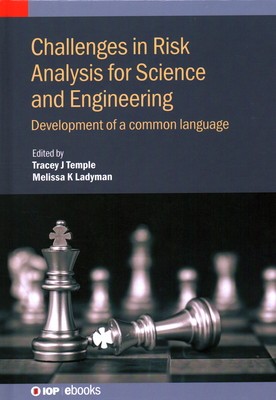
- We will send in 10–14 business days.
- Author: Tracey Temple
- Publisher: IOP Publishing Ltd
- ISBN-10: 0750336412
- ISBN-13: 9780750336413
- Format: 17.8 x 25.4 x 1.8 cm, hardcover
- Language: English
- SAVE -10% with code: EXTRA
Challenges in Risk Analysis for Science and Engineering (e-book) (used book) | bookbook.eu
Reviews
Description
Risk analysis involves the quantification of risk and is essential to all areas of science and engineering. Analysing risk ensures that the hazards or detrimental impacts of research and other activities are identified, mitigated and managed.
The interpretation and implementation of risk assessment has evolved independently within disciplines, which means that small errors in communication have in some cases led to large scale consequences. The aim of this reference text is to provide a common language and consistent approach to risk assessment across disciplines through the collation of detailed, real examples and scenarios.
Examples are drawn from industries including defence, explosive manufacturing, mine action, nuclear, science education and engineering, and focus on key risk topics such as tolerability, data collection, hazard identification and hazard interpretation. The approaches communicate common challenges and are compared and contrasted, with a particular focus on the terminology used.
The book is essential reading for scientists and engineers that undertake risk assessment, including industry practitioners, researchers in academia and those with a general interest in improving risk assessment processes. It is also a valuable reference for science and engineering students that regularly undertake risk assessments or study courses on risk assessment.
Key Features:
- Proposes a common language and consistent approach to risk assessment across science and engineering disciplines
- Creates a bridge between industrial and academic approaches to risk analysis and encourages cross-disciplinary collaboration
- Collates detailed practical examples of risk assessment
- Explores the diverse undertaking of risk assessment in a wide range of disciplines
- Analyses the approaches taken, with a particular focus on the terminology used
EXTRA 10 % discount with code: EXTRA
The promotion ends in 20d.22:31:45
The discount code is valid when purchasing from 10 €. Discounts do not stack.
- Author: Tracey Temple
- Publisher: IOP Publishing Ltd
- ISBN-10: 0750336412
- ISBN-13: 9780750336413
- Format: 17.8 x 25.4 x 1.8 cm, hardcover
- Language: English English
Risk analysis involves the quantification of risk and is essential to all areas of science and engineering. Analysing risk ensures that the hazards or detrimental impacts of research and other activities are identified, mitigated and managed.
The interpretation and implementation of risk assessment has evolved independently within disciplines, which means that small errors in communication have in some cases led to large scale consequences. The aim of this reference text is to provide a common language and consistent approach to risk assessment across disciplines through the collation of detailed, real examples and scenarios.
Examples are drawn from industries including defence, explosive manufacturing, mine action, nuclear, science education and engineering, and focus on key risk topics such as tolerability, data collection, hazard identification and hazard interpretation. The approaches communicate common challenges and are compared and contrasted, with a particular focus on the terminology used.
The book is essential reading for scientists and engineers that undertake risk assessment, including industry practitioners, researchers in academia and those with a general interest in improving risk assessment processes. It is also a valuable reference for science and engineering students that regularly undertake risk assessments or study courses on risk assessment.
Key Features:
- Proposes a common language and consistent approach to risk assessment across science and engineering disciplines
- Creates a bridge between industrial and academic approaches to risk analysis and encourages cross-disciplinary collaboration
- Collates detailed practical examples of risk assessment
- Explores the diverse undertaking of risk assessment in a wide range of disciplines
- Analyses the approaches taken, with a particular focus on the terminology used


Reviews